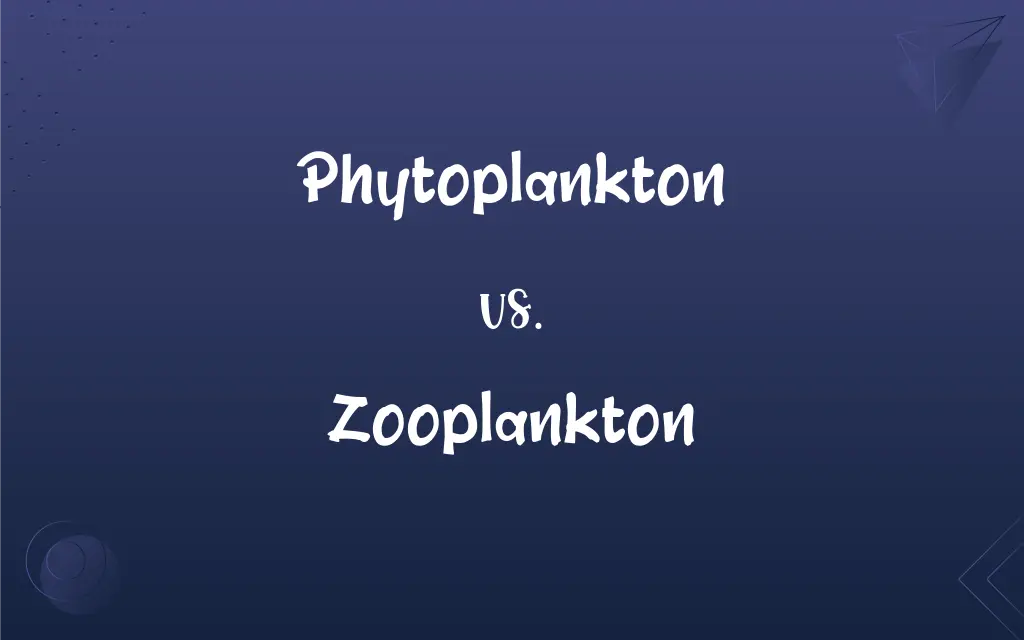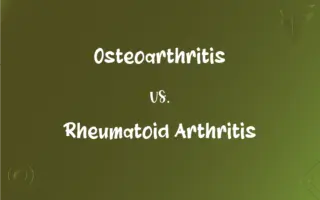Phytoplankton vs. Zooplankton: What's the Difference?
Edited by Aimie Carlson || By Harlon Moss || Updated on October 29, 2023
Phytoplankton are microscopic plants that live in aquatic environments, while zooplankton are small animals that feed on phytoplankton.

Key Differences
Phytoplankton are tiny, microscopic plants that float in water and produce their own food through photosynthesis, contributing to the oxygen in our atmosphere. Zooplankton, on the other hand, are small, floating animals that feed on phytoplankton and other small organisms.
Phytoplankton and zooplankton are both crucial components of aquatic ecosystems, playing key roles in the food chain. While phytoplankton are primary producers that convert sunlight into energy, zooplankton are primary consumers that feed on phytoplankton, transferring the energy up the food chain.
The balance between phytoplankton and zooplankton populations affects the overall health of aquatic ecosystems. If phytoplankton populations are too high, it can lead to algal blooms, while if zooplankton populations are too high, it can lead to a decrease in phytoplankton, affecting other organisms that rely on them for food.
Both phytoplankton and zooplankton are affected by environmental factors such as temperature, nutrient availability, and light. Changes in these factors can have significant impacts on their populations and, consequently, the aquatic ecosystems they inhabit.
In conclusion, phytoplankton and zooplankton are integral to aquatic ecosystems, with phytoplankton serving as the base of the food chain and zooplankton transferring energy to higher trophic levels. Understanding the dynamics between these two groups is essential for managing and conserving aquatic environments.
ADVERTISEMENT
Comparison Chart
Microscopic plants
Type
Small animals
Produce food through photosynthesis
Food production
Consume other organisms
Produce oxygen
Contribution to oxygen
Do not produce oxygen
Primary producers
Trophic level
Primary consumers
Affected by light availability
Environmental factors
Affected by availability of prey
ADVERTISEMENT
Phytoplankton and Zooplankton Definitions
Phytoplankton
Phytoplankton are important indicators of water quality.
A decrease in phytoplankton populations can signal pollution.
Zooplankton
Zooplankton serve as an important food source for many marine species.
Small fish and invertebrates often feed on zooplankton.
Phytoplankton
Phytoplankton serve as the base of the aquatic food chain.
Many small fish and invertebrates feed on phytoplankton.
Zooplankton
Zooplankton are small animals that float in water and feed on phytoplankton.
Jellyfish are a type of zooplankton that can sometimes be seen in large numbers.
Phytoplankton
Phytoplankton are microscopic plants that live in aquatic environments.
The ocean's phytoplankton produce most of the world's oxygen.
Zooplankton
Zooplankton populations can fluctuate greatly.
These fluctuations can have significant impacts on aquatic food webs.
Phytoplankton
Phytoplankton are affected by temperature, light, and nutrient availability.
Changes in these factors can lead to algal blooms or declines in phytoplankton populations.
Zooplankton
Zooplankton are important indicators of water quality.
Changes in zooplankton populations can signal changes in the aquatic environment.
Phytoplankton
Phytoplankton produce their own food through photosynthesis.
The presence of phytoplankton is essential for the survival of marine life.
Zooplankton
Zooplankton are classified into two main types: holoplankton and meroplankton.
Holoplankton spend their entire lives as plankton, while meroplankton are only planktonic during certain life stages.
Phytoplankton
Plankton that consists of minute plants and other photosynthetic organisms, including cyanobacteria, diatoms, and dinoflagellates.
Zooplankton
Plankton that consists of animals, including copepods, rotifers, jellyfish, and the larvae of sessile animals such as coral and sea anemones.
Phytoplankton
Plankton, especially those small in size, that obtain energy by photosynthesis.
Zooplankton
(zoology) Free-floating small protozoa, crustaceans (such as krill), etc. and the eggs and larvae from larger animals.
Phytoplankton
Photosynthetic or plant constituent of plankton; mainly unicellular algae
Zooplankton
Animal constituent of plankton; mainly small crustaceans and fish larvae
FAQs
What do phytoplankton produce?
Phytoplankton produce oxygen through photosynthesis.
What is phytoplankton?
Phytoplankton are microscopic plants that live in aquatic environments.
What is zooplankton?
Zooplankton are small animals that float in water and feed on phytoplankton.
Are phytoplankton primary producers or consumers?
Phytoplankton are primary producers.
What is the main contribution of phytoplankton to the environment?
Phytoplankton produce most of the world's oxygen.
Are zooplankton primary producers or consumers?
Zooplankton are primary consumers.
Are phytoplankton affected by light availability?
Yes, phytoplankton are affected by light availability.
What factors affect zooplankton populations?
Zooplankton populations are affected by the availability of prey.
What are the main threats to zooplankton?
The main threats to zooplankton include pollution and overfishing.
What is the main role of zooplankton in the food chain?
Zooplankton serve as a food source for many marine species.
What are the main types of zooplankton?
The main types of zooplankton are holoplankton and meroplankton.
What is the importance of phytoplankton in aquatic ecosystems?
Phytoplankton serve as the base of the aquatic food chain.
What is the importance of zooplankton in aquatic ecosystems?
Zooplankton transfer energy to higher trophic levels.
How do zooplankton populations affect water quality?
Changes in zooplankton populations can signal changes in the aquatic environment.
Can changes in phytoplankton populations lead to algal blooms?
Yes, changes in phytoplankton populations can lead to algal blooms.
Can fluctuations in zooplankton populations impact aquatic food webs?
Yes, fluctuations in zooplankton populations can have significant impacts on aquatic food webs.
How do phytoplankton populations affect water quality?
A decrease in phytoplankton populations can signal pollution.
What do zooplankton eat?
Zooplankton feed on phytoplankton and other small organisms.
What factors affect phytoplankton populations?
Phytoplankton populations are affected by temperature, light, and nutrient availability.
What are the main threats to phytoplankton?
The main threats to phytoplankton include pollution and climate change.
About Author
Written by
Harlon MossHarlon is a seasoned quality moderator and accomplished content writer for Difference Wiki. An alumnus of the prestigious University of California, he earned his degree in Computer Science. Leveraging his academic background, Harlon brings a meticulous and informed perspective to his work, ensuring content accuracy and excellence.
Edited by
Aimie CarlsonAimie Carlson, holding a master's degree in English literature, is a fervent English language enthusiast. She lends her writing talents to Difference Wiki, a prominent website that specializes in comparisons, offering readers insightful analyses that both captivate and inform.































































